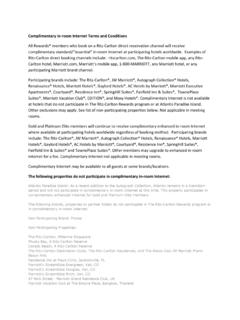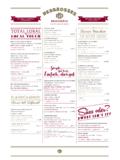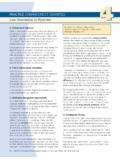Transcription of MODULE Social Skills & Etiquette - The Ritz-Carlton
1 MODULE Social Skills & Etiquette | 45 |MODULES ocial Skills and EtiquetteMODULE GUIDEWe have developed a MODULE Guide to assist you with delivering Social Skills and Etiquette . It is intended as a guide only and can be adapted to best meet the needs of the students. The overarching objective of the presentation is to INSPIRE the students to do their best!The MODULE Guide begins with an Enduring Understanding and Learning Outcomes. The Guide contains a MODULE Overview, which may be used to plan the delivery of the segments. The segments, which are mini-lessons, allow the classroom teacher and facilitator(s) to collaborate for effective grouping of segments into a flexible time frame. The short segments also enable choice among facilitators, as they may select which topic/segment they would like to cover. Some of the longer or more complex segments include a specific Enhancement(s) or Follow-up Idea(s). These optional ideas may be utilized by either the facilitator(s) or by a classroom teacher, who may be interested in extending the to Enrich and Extend the MODULE are provided in the Succeed Through Service Resource Guide to help facilitators and the classroom teacher further expand the segments in the MODULE .
2 These resources are aligned with the Universal Design for Learning (UDL). The Succeed Through Service Resource Guide also provides additional information including links to the Common Core Standards. Remember to incorporate FUN into the MODULE . Consider using music, visuals, personal stories and examples, and/or some of the additional resources to bring the presentation alive! endurinG underStandinGSocial Skills and proper Etiquette contribute to better communication in any outCoMeSAt the end of this MODULE , students will be able to do the following: Create a great impression and professionally interact and communicate with others by applying the necessary personal Skills and manners. Apply personal and professional Skills and manners in a variety of Through Service | TOOLKIT| 46 |tiMe: 1 hour+ (The presentation has enough content to be expanded in length if time available.)loCation: On-property note: The session includes guidance on table Etiquette and the tables should be set with cutlery, water glasses, bread plates and napkins, etc.
3 It is not necessary to serve a meal to the : Laptop, LCD projector, document, camera/overhead, and : A summary of the session (example attached), one copy per student; sticky notes; laptop; LCD projector; document camera/ overhead projector; chart paper and markersFaCilitatorS: Succeed Through Service Team, made up of leaders and employees from a selection of depart-ments. The suggested Script(s) and Segues with their italicized words are provided as a : This MODULE is designed to actively involve the attendees in developing the knowledge, Skills and abilities crucial to achieving the Enduring Understanding and demonstrating the outcomes listed overvieWThis MODULE is designed to actively involve the students in developing the knowledge, Skills and abilities crucial to demonstrate basic personal and professional Social Skills and Etiquette . Part of the series of Succeed Through Service presentations, Social Skills and Etiquette consists of 12 segments captured under five and Purpose1.
4 Welcome to Social Skills and Etiquette2. Overview of today s sessionSocial Skills and Etiquette Defined3. What are Social Skills ?4. What is Etiquette ? Social Skills5. A positive and lasting first impression6. Name usage7. Handshakes8. Small courtesiesEtiquette9. Telephone Etiquette10. Grooming11. Table EtiquetteRecap and Post-Assesment12. Review and post-assessment| 47 | MODULE 2 Social Skills and Etiquette |WelCoMe and PurPoSe SeGMent 1: Welcome to Social Skills and Etiquette tiMe: 7 minutesaCtivitieS:1. Teacher introduces facilitators to the Brief introductions by the facilitators (names, positions and brief career paths) if this is the first time they have met the class. Depending on the size of the class and space available the icebreaker can be done in one group or smaller SCriPt: I would like to share with you one of my favorite icebreakers! It s called The Last Word. 1. Let s stand in a circle. 2. I will move and stand randomly in front of one of I will then make a statement ( , It is such a lovely day ).
5 4. The person I spoke to will then move to another person and make another statement starting with the last word in the statement he/she So in this case, the word is day. The person whom I spoke to might say something like, Day one of summer is always warm and beautiful. 6. Each participant takes turns to ensure that everybody gets a chance to participate. 7. Are you ready? Isn t it a wonderful icebreaker? It teaches you to listen carefully to what another person is saying, and it gives you the opportunity to practice being able to think on your : Congratulations for being such great team players! Let s find out what we re going to cover today. Topic/Timing Scripting/Direction ResourcesSucceed Through Service | TOOLKIT| 48 | SeGMent 2: overview of Today s Session tiMe: 1 minuteSCriPt/viSual: During the next hour, Social Skills and Etiquette will provide you with the necessary knowledge and Skills to help you understand:1. The personal Skills and manners needed to create a great impression, as well as professionally interact and communicate with How to apply personal and professional Skills and manners in different situations and Quickwrite: Introduce the Enduring Understanding (EU) for the unit: Social Skills and proper Etiquette contribute to better communication in any students to read the EU above and complete a quickwrite (a piece of writing completed in a very short period of time) jotting what they think Social Skills and Etiquette are based upon the context of the EU.
6 They may use words, phrases, or : Let s start by defining Social Skills . | 49 | Social Skills and Etiquette deFined SeGMent 3: What are Social Skills ? tiMe: 2 minutes SeGMent 4: What is Etiquette ? tiMe: 2 minutesaCtivitieS/SCriPt:1. brainstorm: What comes to your mind when you hear the words Social Skills ? (If students completed the quickwrite during Segment 2, they may refer to their notes. Solicit responses and recognize participants. Write answers on the black/whiteboard or flip chart). What does it look like when a person doesn t have Social Skills ? (These are referred to as non-examples ). Great job everyone! Social Skills are the set of Skills you need to successfully interact and communicate with others. Social Skills help a person to navigate this big, confusing world without offending others, so to speak. For example: - Providing a warm greeting when you meet someone. - Listening to someone when they re talking to you.
7 - Interacting positively in a group : Now that we know what Social Skills means, let s define Etiquette and find out how this word is connected to Social Skills ! aCtivitieS/SCriPt:1. brainstorm: In what context have you heard the word Etiquette ? (Solicit responses and recognize participants. Write answers on the black/whiteboard or flip chart). Topic/Timing Scripting/Direction ResourcesMODULE 2 Social Skills and Etiquette |Succeed Through Service | TOOLKIT| 50 | SeGMent 4: What is Etiquette ? cont .. SeGMent 5: A Positive and lasting First impression tiMe: 8 minutes ENHANCEMENT Consider mapping the word by using Consider using a video to illustrate examples and non-examples of good Etiquette . Again, great job! Etiquette really is about having good manners. For example Using words like please and thank you. Keeping elbows off the table. Opening doors for other people. Chewing food with your mouth : Now we re going to apply Social Skills and Etiquette in different settings, starting with making a first impression.
8 ACtivity/SCriPt: When we meet someone for the first time, we have an opportunity to make either an excellent or poor first impression. 1. brainstorm: What can we do to make a positive first impression? (Solicit responses and recognize participants. Write answers on the black/whiteboard or flip chart). Thanks everyone! Social Skills Topic/Timing Scripting/Direction Resources| 51 | SeGMent 5: A Positive and lasting First impression cont .. Factoids: Did You Know?One of the best techniques to ensure eye contact is to note the eye color of the person with whom you are speaking. It takes 43 muscle to frown and only 17 to smile!2. Lecturette: Here are the top four techniques to remember when making a positive first impression: Eye Contact - People speak with their eyes as well as their voices. Maintain eye contact to show interest. Facial expressions - Don t forget to give a genuine smile. Let your face reflect what you are saying! Energy in your voice - Remember to project interest.
9 Make sure you speak loudly enough for the other person to hear you and, of course, get rid of the Ums and Uhs! Polite greeting Good Afternoon, Hello, Great to see you. We don t have a second chance to make a first impression!ENHANCEMENTF ictional Scenarios - Create characters that the students could practice greeting. (Examples could include a person who is holding a map and is clearly lost, a clerk at a retail store, a new student on the first day of school, etc.) Ask the students to practice some of those steps as you explain it). MODULE 2 Social Skills and Etiquette |Succeed Through Service | TOOLKIT| 52 | SeGMent 5: A Positive and lasting First impression cont .. SeGMent 6: name usage tiMe: 2 minutes3. Practice: Remember: I hear and I forget. I see and I remember. But when I practice, I really understand! So let s do some role plays! Divide the students in teams of two and ask each team to practice providing a warm welcome by incorporating the aforementioned 4 Steps).
10 SEGUE: Awesome job everyone! Now the next important step in mak-ing a positive first impression is using a person s name!aCtivity/SCriPt: People always like to hear their names when they are you know why?Because your name is the sweetest sound to your ear! In addition, you will always feel valued when they refer to you using your name! Correct?Now, what are some of the tips for proper name usage? (Solicit responses and recognize participants. Record answers on the black/whiteboard or flip chart).1. Always address adults by their formal name (Mr. Jones, Mrs. Smith, Dr. Stevens); and2. Try to use a person s name throughout the : Are you ready for the next Social skill? Let s talk about the importance of handshakes when being introduced.| 53 | SeGMent 7: Handshakes tiMe: 4 minutesaCtivity/SCriPt:1. brainstorm: What are the important things to remember when shaking hands? (Solicit responses and recognize participants. Record answers on the black/whiteboard or flip chart).














